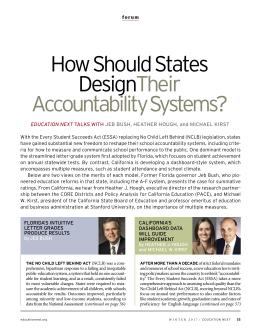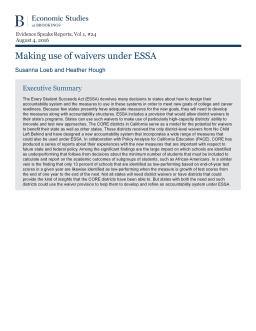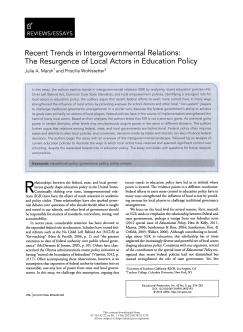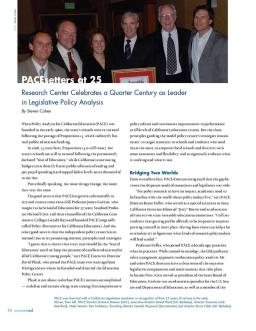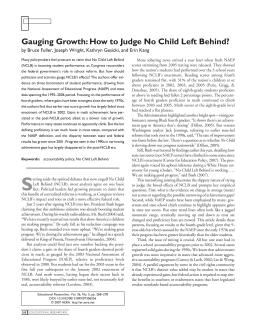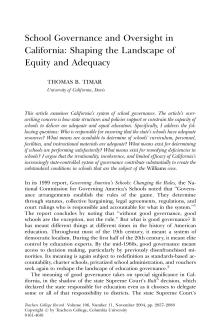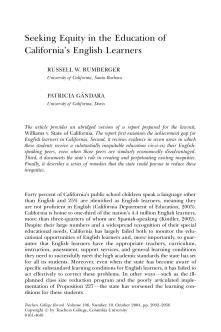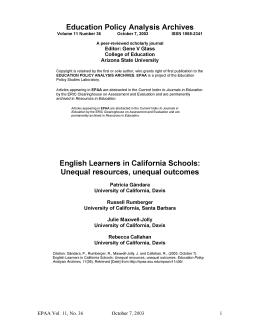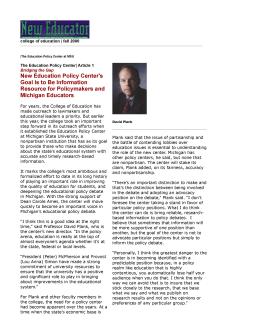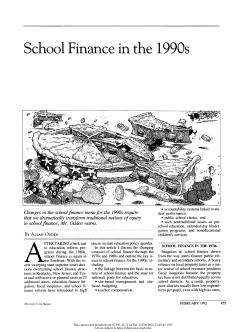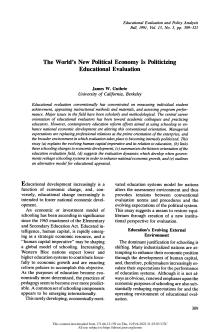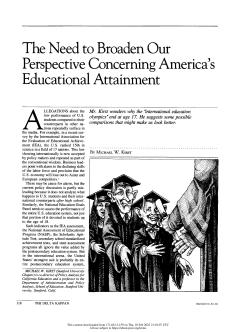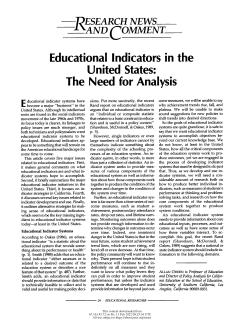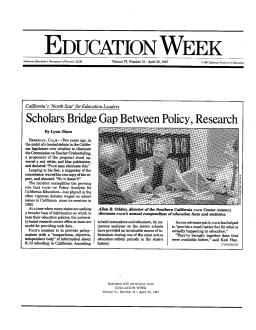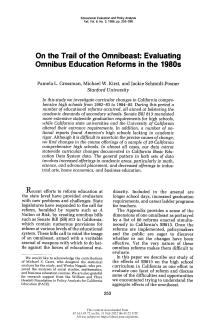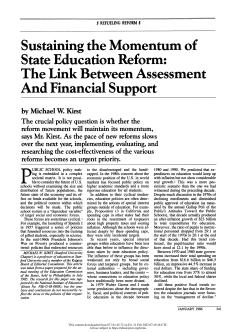Published
Summary
The Every Student Succeeds Act (ESSA) allows states to reshape their school accountability systems. One dominant model is the letter-grade system first adopted by Florida, while California is developing a dashboard-style system that encompasses multiple measures such as student attendance and school climate. Former Florida Governor Jeb Bush presents the case for summative ratings, while Heather J. Hough and Michael W. Kirst of PACE stress the importance of multiple measures.
Insights From California’s CORE Waiver Districts
Published
Summary
California's Local Control Funding Formula (LCFF) aims to improve educational equity by providing additional funds to districts with disadvantaged students. Districts are required to engage with their communities and develop Local Control Accountability Plans (LCAPs) to identify priorities and allocate funds. However, there are concerns about the quality of LCAPs, lack of stakeholder involvement, and limited transparency. To improve the effectiveness of LCFF, districts must ensure meaningful stakeholder engagement and use data to guide decision-making.
How a Research Center Based at USC Rossier, Stanford and UC Davis Is Helping California Forge Its Own Path in Advancing Its Education System
Published
Summary
Policy Analysis for California Education (PACE) is a consortium of researchers, policymakers, and practitioners from USC Rossier, Stanford, and UC Davis Schools of Education working to improve education policy in California. PACE's focus has been the Local Control Funding Formula (LCFF), which changed the state's K-12 budget allocation. The consortium's strength is in its ability to get research into the hands of decision makers, especially in Southern California, where over a quarter of the state's K-12 students reside.
Learning from the CORE Districts' Focus on Measurement, Capacity Building, and Shared Accountability
Published
Summary
California and the US are undergoing a cultural shift in school accountability policies towards locally-determined measures of school performance. Lessons can be learned from the CORE districts, which developed an innovative accountability system, emphasizing support over sanctions, and utilizing multiple measures of school quality. The CORE districts' measurement system and collaboration hold promise for improving local systems, but efforts to build capacity remain a work in progress.
Published
Summary
ESSA allows states to design accountability systems and measures to meet new college and career readiness goals. With the lack of adequate measures, states will need to develop new measures and structures. The CORE Districts in CA, with its innovative accountability system and waivers from No Child Left Behind, is a model for other states. Reports from CORE-PACE highlight the impact of decisions such as subgroup sizes and test score growth on identifying low-performing schools. States can use the district waiver provision to help develop and refine their accountability systems under ESSA.
The Resurgence of Local Actors in Education Policy
Published
Summary
This article analyzes recent education policies to explore trends in intergovernmental relations. The authors argue that federal efforts to exert more control have actually strengthened the influence of local actors, creating a bidirectional relationship between federal, state, and local governments. Local actors have retained and asserted significant control over schooling, despite the expanded federal role in education policy. The article concludes with questions for future research and practice.
Research Center Celebrates a Quarter Century as Leader in Legislative Policy Analysis
Published
Summary
The call for improved education persists annually within PACE, emphasizing the perpetual need for progress. Even with strides made, the organization does not consider its mission accomplished. Guided by three core principles—allocating resources to disadvantaged schools, granting autonomy to local districts, and rigorous evaluation of educational efficacy—PACE remains dedicated to fostering lasting policy reform and enhanced educational performance across California's system. Leveraging experience from Michigan State's Education Policy Center, PACE's leadership continues to drive the...
School Finance and Governance in California
Published
Summary
Getting Down to Facts is an extensive investigation of CA's public education system commissioned by a bipartisan group of CA leaders. The project aimed to describe California's school finance and governance systems, identify obstacles hindering resource utilization, and estimate costs to achieve student outcome goals. The project resulted in 23 reports by scholars, which highlight that the current school finance and governance systems fail to help students achieve state performance goals, particularly those from low-income families. The reports provide a framework for assessing reform options.
How to Judge No Child Left Behind?
Published
Summary
This report analyzes the effects of No Child Left Behind (NCLB) on student performance using three barometers: the National Assessment of Educational Progress (NAEP), state data, and fourth-grade test scores. The authors find that earlier test score growth has largely faded since NCLB's enactment in 2002, and progress made in narrowing achievement gaps in the 1990s has largely disappeared in the post-NCLB era. The report suggests that policymakers need to reconsider the efficacy of NCLB and consider alternative approaches to school reform.
Shaping the Landscape of Equity and Adequacy
Published
Summary
This report focuses on California's school governance system and how it affects schools' ability to provide an adequate and equal education. The author examines who is responsible for ensuring adequate resources, how to assess adequacy, how to determine school performance, and how to address deficiencies. The report argues that California's state-controlled governance system is irrational, incoherent, and limited in efficacy, contributing to substandard school conditions, as seen in the Williams v. California case.
Published
Summary
This article presents a summary of a report prepared for the Williams v. State of California lawsuit, highlighting the achievement gap for English learners in California and seven areas where they receive an inequitable education compared to their English-speaking peers. It also documents the state's role in perpetuating these inequities and proposes remedies to reduce them.
Unequal Resources, Unequal Outcomes
Published
Summary
This article discusses the inequitable education provided to English language learners in California, arguing that there are seven areas where these students receive an inferior education compared to English speakers. That includes having less qualified teachers, inferior curriculum, and being assessed with invalid instruments. The article provides suggestions for addressing these issues.
New Education Policy Center's Goal Is to Be Information Resource for Policymakers and Michigan Educators
Published
Summary
Michigan State University's College of Education has established the nonpartisan Education Policy Center to provide lawmakers and educational leaders with accurate, research-based information to improve the state's educational system. With the support of the university's resources, the center aims to play an important role in deepening the policy debate and bringing about improvements in the system. The center was established due to a lack of systematic communication between researchers and policymakers in Michigan.
Published
Summary
The article discusses the importance of parent involvement in education and its effects on student achievement. It suggests that schools need to create a welcoming environment for parents and engage them in meaningful ways, such as through volunteering and decision-making committees. Additionally, the article emphasizes the need for schools to provide information and resources to parents, especially those who are disadvantaged, to ensure that they are equipped to support their children's learning at home.
Published
Summary
School finance has become a prominent issue again due to court decisions and litigation in several states. This article explores school finance changes in the 70s and 80s and outlines key issues for the 90s, including the relationship between finance and education goals, site-based management, teacher pay, accountability, school choice, and nontraditional issues such as preschool and non-educational services for children.
Published
Summary
Traditionally, educational evaluation has focused on measuring student achievement and program performance. However, education reforms are now linking schooling to economic development, leading to a shift towards managerial expectations and politicization of the field. This article explains the human capital imperative and its relation to education, summarizes the history of educational evaluation, and outlines an alternative model for educational appraisal in the context of government-led education system reforms aimed at enhancing national economic growth.
Published
Summary
The U.S. ranks low in international education comparisons, but the discussion is misleading because it does not look at postsecondary education. The value added by the postsecondary education system, including community colleges, trade schools, and universities, is ignored. The U.S.'s strongest suit is probably its entire postsecondary education system in the international arena.
The Need for Analysis
Published
Summary
Educational indicator systems are in demand in the US due to their strong linkages to policy issues. This article covers five major issues related to educational indicators, including what they are, major initiatives in the US, and indicator strategies in California. It also discusses key issues related to indicator development and use and outlines alternative strategies for making sense of educational indicators, which are currently missing in the US.
An Exploration of the Debate on School District Size
Published
Summary
The notion that larger school districts are superior has changed, with some researchers advocating for smaller ones. Recent reform reports have focused on the school site as the decision-making seat. Three main issues guide district size research: fiscal efficiency, school effectiveness, and community identity. Although research has been conducted, there is still no definitive answer. This article explores the research and debate on the "right" size for school districts and identifies unanswered questions, hoping to kindle interest in further research.
Published
Summary
PACE, a university-based research center, provides "nonpartisan, objective, independent" information on K-12 schooling in CA. Its analyses have been invaluable to lawmakers and educators during the state's active education-reform period. PACE has played a growing role in debates on school issues, exemplified by a heated debate in the CA legislature over the Commission on Teacher Credentialing. PACE offers a model for providing data for education policies when many states are seeking broader information bases. It has helped provide a better understanding of what is happening in education.
Evaluating Omnibus Education Reforms in the 1980s
Published
Summary
The study examines curricular changes in California's high schools from 1982 to 1985, a period of educational reforms aimed at increasing academic rigor. The state mandated more extensive graduation requirements while universities adjusted their entrance requirements. A sample of 20 comprehensive high schools shows increased academic offerings in math, science, and advanced placement, and decreased offerings in industrial arts, home economics, and business education, reflect statewide trends.
The Link Between Assessment and Financial Support
Published
Summary
Public school policy making is embedded in a complex societal matrix. It is not possible to consider the future of U.S. schools without examining the size and distribution of future populations; the future state of the economy and its effect on funds available for the schools; and the political context within which decisions will be made. The public school system is a "dependent variable" of larger social and economic forces.
